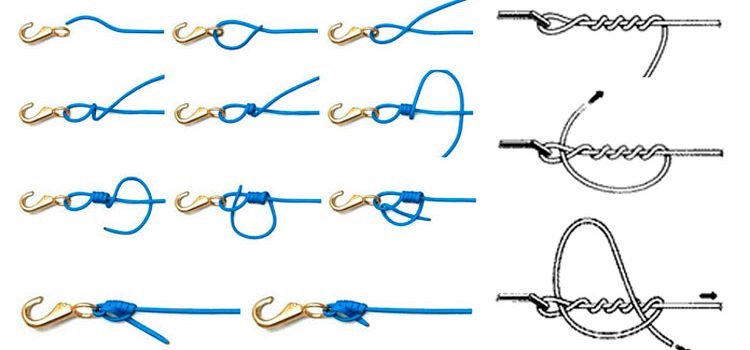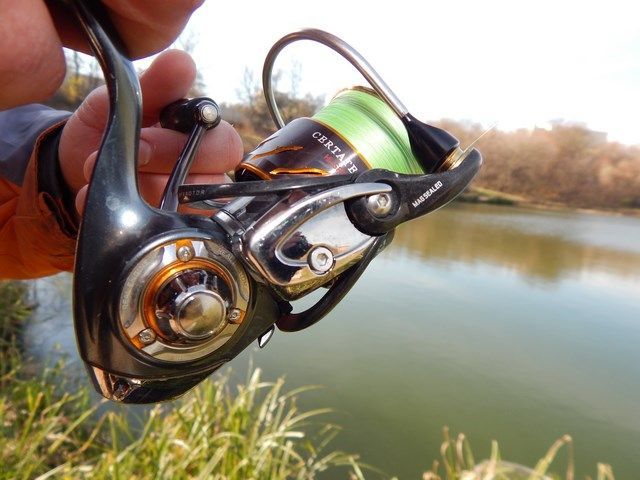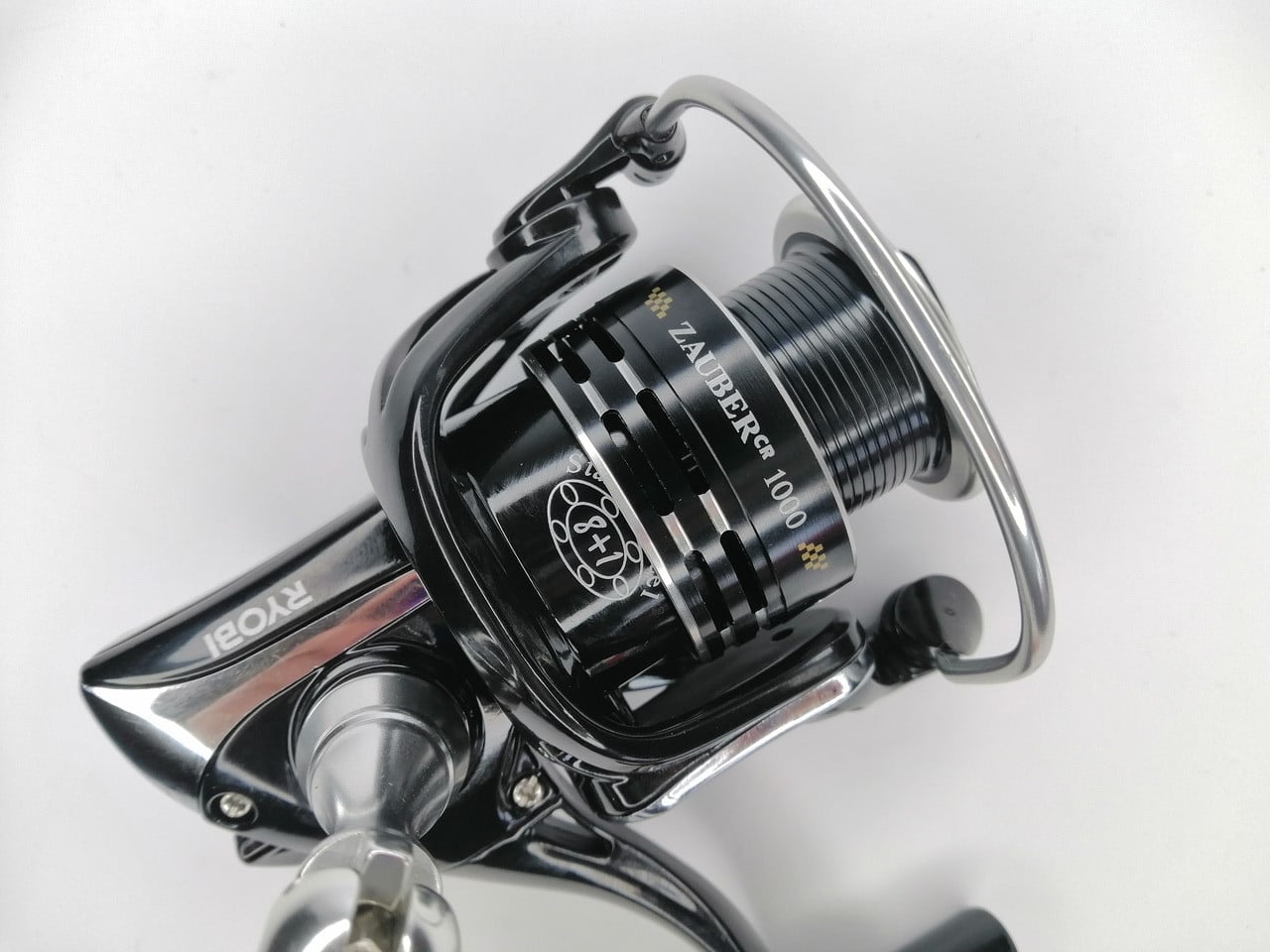The fishing clinch in various versions is often used in spinning fishing. One of the most effective ways to use a clinch is to tie a leash, hooks, swivels, and accessories. Those fishermen who use the usual loop-in-loop knot for this purpose scare the fish away, since it is more noticeable to the fish. the clinch solves this problem by securing the tackle with a secure knot. The clinch assembly can be used to attach sinkers, hooks,
swivels , jig heads, feeders and other tackle elements. It is believed that this knot demonstrates the greatest strength in those cases when the diameter of the lug does not exceed 1.2 mm.
How to knit a regular clinch knot – a diagram with a photo
To tie a clinch, you need to do the following:
- Pass the free end of the line through the eyelet. This needs to be done with a large margin. It is threaded so that it turns out to be at least 15 cm.
- After the eyelet, the end of the line is wrapped 5-6 times, moving towards the main part of the line. When wrapping it, you do not need to tighten the thread tightly.
- After that, the tip is threaded into a loop that has formed near the ear itself.
- After that, the knot must be moistened and tightened. The protruding tip needs to be trimmed.
The knot strength is 85%. When using it, the strength of the tackle will be the specified value from the original. This version of the node is considered the main one and is used most often. Each step of creating a clinch is shown in the figure.
How to knit a double clinch knot
This knot is used when a high strength knot is needed. To knit it, perform the following actions:
- The double end is threaded so that the double end passes completely through the eyelet.
- The double thread is wrapped 4-5 times around the main part. In this case, a single tip of the required length should remain.
- It needs to be threaded into the fold.
- Now the knot needs to be moistened and tightened. After that, the protruding tip is cut off.
Each step of creating a node is reflected in the following figure.
Reinforced clinch knot
Such a knot is usually used for attaching hooks in cases where it will be subjected to significant stress. To tie this knot, you need to do the following:
- You need to thread the fishing line into the eyelet at a distance of at least 15 cm.
- Wrap the tip around the fishing line 5-6 times. These rings should not be tight. It is necessary to wrap the line in the direction from the eyelet to the main part of the line.
- You need to make another loop as follows: the tip is threaded into the hole that goes first from the loop.
- After that, the line will need to be threaded through the newly created large loop.
- The knot must be wetted. After that, it must be carefully tightened.
The operations described here can be clarified by examining the following diagram.
This knot provides 98% strength versus 85% of the classic clinch
Locking clinch
The use of stop knots is intended to create a thickening that will restrict the movement of the tackle element within the required limits. There is a variant of the clinch knot that is used as a stopper. In this case, a knot is created, for example, from a woolen thread, to tie the fishing line. To link it, you will need to perform the following operations:
- The thread is folded in half and placed along the line.
- Starting from the double end, one part of the thread is wrapped 6-7 times around the second part of the thread and fishing line. In the process of knitting, you need to follow that. So that the turns are neat and parallel to each other.
- The end of the thread, which was carried around, is threaded in the place of the original fold.
- To tie a knot, you need to take the two ends and pull in different directions. The protruding ends must be trimmed. The knot must be wetted before tightening. The size of both ends must be at least 2 cm.
The details of the node creation process can be seen in more detail in the following figure.
Reinforced clinch
This knot provides up to 95% strength. When fishing for large, energetic fish is planned, it is beneficial to use a hardened clinch. To do it, you need to take the following steps:
- The end of the line must be folded in half. The resulting double thread is pulled through the eyelet about 15 cm.
- The double end is wrapped around the main part of the line 4-5 times.
- Then it is brought back and carried through the loop near the ear.
- It is necessary to wet and tighten the line. The protruding tip needs to be carefully trimmed.
You can clarify the sequence of operations by examining the proposed scheme.
Pros and cons of the clinch knot, where it is applied, when not to apply
Using this knot, the fisherman can take advantage of the following benefits:
- To link it, you need to perform very simple operations. All clinch options are not difficult to create. Even a beginner can confidently use them.
- This knot can be used even if the tying eye is small.
- The knot is effective even for very thin lines.
- The clinch is well suited for knitting fine to medium monofilament lines.
When using it, it must be borne in mind that it has certain disadvantages:
- For braids with a smooth surface, the knot is not used.
- Not recommended for slotted holes.
- The knot is not recommended for large lugs.
- It is believed that this knot is not suitable for thread thicker than 0.4 mm.
Although the clinch can be used in cases where this is not recommended, its strength in such cases will be significantly lower than usual.
Clinch knot for braids how to knit pattern and explanation – improved and hardened Clinch Knot for line and cord, visual video: https://youtu.be/n5GIuLBY-xE
Possible difficulties and their solution
When creating a knot, it must be borne in mind that it reduces the strength of the tackle. This happens for several reasons. The frictional force when tightening the knot slightly destroys the line, which affects its performance. Friction creates overheating, which also reduces strength. The more breaks in the thread, the more the reliability of the connection decreases. To reduce this influence, it is enough to dampen the line before tightening. Due to the wetting, the effect of the frictional force will be weaker. Usually, after tying the knot, there is a sticking out tip. It is customary to cut it off. It should be remembered that this cannot be done close to the node. It is necessary to leave at least 3 mm in order to exclude spontaneous untiing. In some cases, it is required to thread not a single, but a double thread through a narrow eyelet. If the hole is very thin, it will be difficult to do this.In this case, it will be convenient to carry out the procedure in the following way:
- Thread a single thread into the eyelet to the required length.
- Then thread the tip back, leaving a double thread on the right side.
After that, you can continue tying the knot according to the appropriate instructions. When knitting a stopper knot, there is a requirement that the length of the ends should not be less than 2 cm. This has the following explanation. If the tips are short, they will show considerable stiffness. With a length of 2 cm, they will become much more flexible. In this case, passing through the rings, they will not cling to them. The second reason is that over time, being in the water for a long time, this knot will weaken. The long ends make it easy to tighten again. How to knot a san diego clinch knot to tie your hook to fishing line: https://youtu.be/bAP5Hvqflxw
Similar nodes
The use of the clinch assembly allows for a strong and reliable connection. However, the fisherman should be aware that similar knots can also be used. One of them is the grinner. To do it, you need to follow these steps:
- The fishing line is threaded into the eye of the swivel. This must be done with a large margin so that there is enough to knit this knot.
- The threaded end is divided into approximately three equal parts. After the first third, it is folded back.
- From the eyelet towards the main part of the line, the tip is wrapped around the double thread so that the turns are located inside the large loop. You need to make 4-5 turns.
- When the last one is completed, the thread is threaded again inside the large loop.
- After wetting, the knot is carefully tightened so that it retains its shape. The protruding tip must be trimmed.





